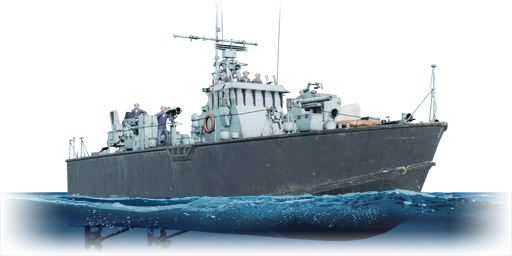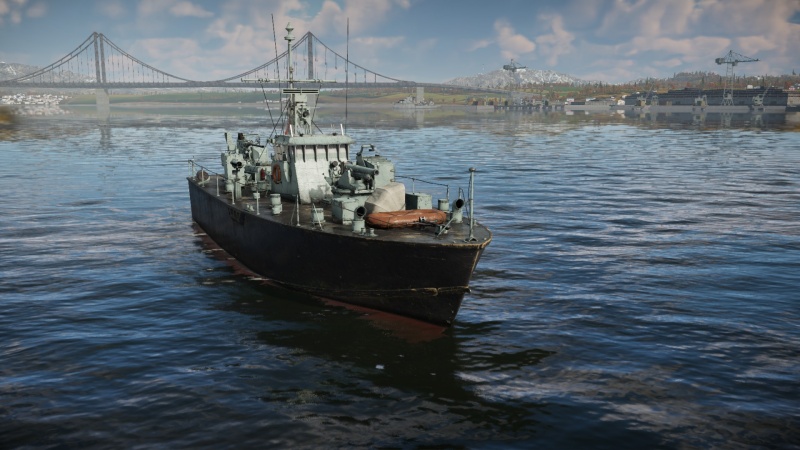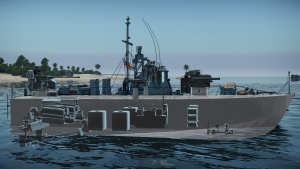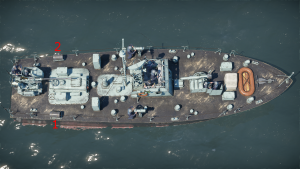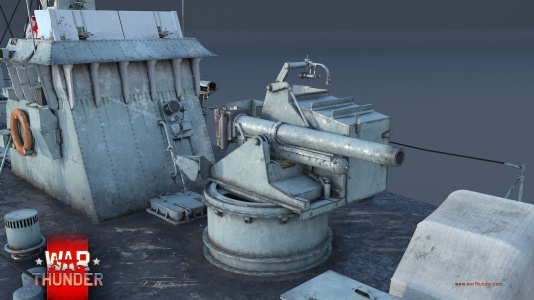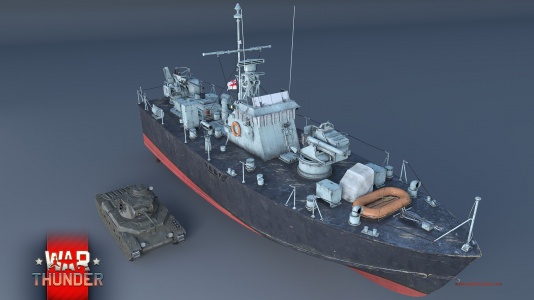Dark Adventurer
Contents
Description
The Dark-class, Dark Adventurer (FPB 1101) was the lead ship of the Dark-class fast patrol boats built for the Royal Navy in the mid-1950s. The boats featured alloy framing and wooden decks and skin. 27 were ordered in 1954, but nine were cancelled a year later. The ships featured interchangeable armament which meant they could serve in both motor gun boat and motor torpedo boat roles, depending on their task. They were also the only diesel engine-powered fast patrol boats in the entire Royal Navy. Dark Adventurer was launched on 28th October 1954 and sold in January 1970.
The Dark Adventurer was introduced in Update 1.83 "Masters of the Sea" as part of the British fleet closed beta test. With the split of the naval tech trees in Update "New Power", Dark Adventurer was moved to the coastal fleet tech tree. The Dark Adventurer is depicted in the motor gun boat configuration featuring a single 114 mm gun on the bow and 40 mm Bofors autocannon on the stern with no torpedo launchers. Her sister Dark Aggressor is depicted in the motor torpedo boat configuration with four 533 mm torpedo tubes and 40 mm autocannon on the bow.
General info
Survivability and armour
Dark Adventurer has the following armour layout:
- 114 mm 8cwt QF Mk I gunshield: 12.7 mm, hardened armour
- Hull: 40 mm, wood
- Superstructure: 15 mm, wood
Like most coastal vessels, Dark Adventurer has no practical armour. The gunshields are largely superficial; while they may stop low-calibre machine guns, heavy machine guns and cannons will easily penetrate them at any range. The hull and superstructure are unarmoured and will not stop any sort of gunfire.
The hull is split into four hull sections. Starting from the bow and working towards the stern, the first section starts at the bow and ends just in front of forward gun; the second ends just after the bridge; the third ends where the fuel tanks end, just in front of the engines; and the fourth ends at the stern.
Any round with a large enough diameter and explosive mass can hull break Dark Adventurer. In general, this is limited to HE rounds greater with a diameter greater than or equal to 4 inches (102 mm) and with an explosive mass greater than 1.5 kg. At Dark Adventurer's own battle rating, there is only one gun capable of hull-breaking her:
- the 114 mm 8cwt QF Mk I, found on Dark Adventurer herself.
There is one ammunition storage that holds ammunition for both the primary and secondary gun turrets. It is located directly behind the forward gun turret just above the waterline. Destroying it will instantly destroy Dark Adventurer.
Dark Adventurer has a crew complement of 15. With a stock crew, Dark Adventurer is knocked out when 10 crew are lost; with an aced crew, this is increased to 11. Overall, the survivability is average.
Mobility
| Mobility Characteristics | |||||
|---|---|---|---|---|---|
| Game Mode | Upgrade Status | Maximum Speed (km/h) | Turn Time (s) | Turn Radius (m) | |
| Forward | Reverse | ||||
| AB | Stock | 73 | 27 | ~26.46 | ~53.37 |
| Upgraded | 100 | 37 | ~17.53 | ~22.22 | |
| RB/SB | Stock | 64 | 24 | ~29.42 | ~67.67 |
| Upgraded | 74 | 27 | ~23.53 | ~42.2 | |
Dark Adventurer has a displacement of 64 tons.
Modifications and economy
The recommended modification research order is:
- Tool Set
- Fire Protection System
- 40 mm HE clips
- 40 mm AP clips
- Smokescreen
- Propeller Replacement
- Improved Rangefinder
- Artillery Support
After that, prioritize the rest of the seakeeping modifications first, then finish researching the remaining modifications in whatever order you prefer.
Armament
Primary armament
The primary armament consists of a single 114 mm 8cwt QF Mk I cannon mounted forwards, with a maximum ammunition load of 100 rounds. Stock, the mount can traverse horizontally at a rate of 26°/s and vertically at a rate of 21°/s; with the "Primary Armament Targeting" modification installed, this is increased to 30°/s and 25°/s respectively. The gun is single-shot with a nominal rate of fire of 12 rounds/min. With a stock crew, it can be reloaded in 6.5 seconds; with an aced crew, this is decreased to 5 seconds.
| Primary armament guidance | |
|---|---|
| Horizontal | Vertical |
| ±180° | -8°/+12° |
There is only one ammunition type available:
| Penetration statistics | |||||||
|---|---|---|---|---|---|---|---|
| Ammunition | Type of warhead |
Penetration @ 0° Angle of Attack (mm) | |||||
| 1,000 m | 2,500 m | 5,000 m | 7,500 m | 10,000 m | 15,000 m | ||
| 114 mm HE | HE | 34 | 34 | 34 | 34 | 34 | 34 |
| Shell details | ||||||||||||
|---|---|---|---|---|---|---|---|---|---|---|---|---|
| Ammunition | Type of warhead |
Velocity (m/s) |
Projectile mass (kg) |
Fuse delay (m) |
Fuse sensitivity (mm) |
Explosive mass (TNT equivalent) (kg) |
Ricochet | |||||
| 0% | 50% | 100% | ||||||||||
| 114 mm HE | HE | 457 | 6.66 | 0 | 0.1 | 2.9 | 79° | 80° | 81° | |||
The 114 mm HE round is able to hull break most coastal vessels smaller than sub-chasers.
Secondary armament
The secondary armament consists of a single 40 mm QF Mk VII cannon mounted aft with a maximum ammunition load of 1,500 rounds. Stock, the mount can traverse horizontally at a rate of 34°/s and vertically at a rate of 29°/s; with the "Auxiliary Armament Targeting" modification installed, this is increased to 40°/s and 34°/s respectively. The gun has a magazine capacity of 4 rounds and a cycle rate of fire of 160 rounds/min. With a stock crew, it can be reloaded in 0.49 seconds; with an aced crew, this is decreased to 0.38 seconds. The reload is short enough that there is a seamless transition between magazines, although continuously firing for too long will cause the gun to overheat and jam. This happens after continuously firing for about 1.25 min, or about 200 rounds. There is no noticeable drop in accuracy as the gun overheats.
| Secondary armament guidance | |
|---|---|
| Horizontal | Vertical |
| ±180° | -10°/+89° |
There are three ammunition types available:
- Universal: AP-T · HEFI-T
- 40 mm HE clips: HEFI-T · HEFI-T · HEFI-T · AP-T
- 40 mm AP clips: AP-T · AP-T · AP-T · HEFI-T
| Penetration statistics | |||||||
|---|---|---|---|---|---|---|---|
| Ammunition | Penetration @ 0° Angle of Attack (mm) | ||||||
| 10 m | 100 m | 500 m | 1,000 m | 1,500 m | 2,000 m | ||
| HEFI-T | 3 | 3 | 3 | 3 | 3 | 3 | |
| AP-T | 81 | 78 | 68 | 58 | 49 | 41 | |
| Shell details | ||||||||||||
|---|---|---|---|---|---|---|---|---|---|---|---|---|
| Ammunition | Velocity (m/s) |
Projectile mass (kg) |
Fuse delay (m) |
Fuse sensitivity (mm) |
Explosive mass (TNT equivalent) (g) |
Ricochet | ||||||
| 0% | 50% | 100% | ||||||||||
| HEFI-T | 874 | 0.9 | 0 | 0.1 | 67.13 | 79° | 80° | 81° | ||||
| AP-T | 874 | 0.89 | - | - | - | 47° | 60° | 65° | ||||
The best ammunition is the 40 mm HE clips because it has the highest ratio of HE rounds to AP rounds. Take mostly 40 mm HE clips along with several 40 mm AP clips for armoured targets. Because of the gun's seamless reload, there is no reason to use the Universal belt once the others are unlocked.
Additional armament
Dark Adventurer has two possible loadouts:
- Without load
- 2 x Mk.VII depth charge
Depth charges
The Mk.VII depth charges are carried amidships in front of the aft gun, one on each side. They are dropped one at a time in the following order:
- Starboard
- Port
Before spawning, the detonation time delay can be set anywhere between 3 seconds and 10 seconds.
| Depth charge characteristics | ||||||
|---|---|---|---|---|---|---|
| Mass (kg) | Explosive type | Explosive mass (kg) | TNT equivalent (kg) | HE armour penetration (mm) | Armoured vehicle destruction radius (m) | Fragment dispersion radius (m) |
| 196 | TNT | 130 | 130 | 101 | 8 | 122 |
There is almost no practical reason to use depth charges on any naval vessel in the game. Although they usually result in a one-hit kill if used properly, they are extremely situational, requiring the player to close to point-blank ranges to even use them. In almost every case, anytime a depth charge could be used, the guns can be used instead to greater effect. In fact, depth charges tend to actually be a liability in battle, since they essentially act as exposed ammo racks before they're dropped. They can be shot at, and if destroyed, they have a chance to detonate, instantly destroying the boat.
Despite this, some success can be had in dropping them either next to, or in front of a large, slow target. If dropping them next to the target, remember the depth charge drop order, since it's most likely that only the depth charges dropped on the side closest to the enemy will deal any damage. If dropping in front of the target, rush in from the sides as quickly as possible and drop them all at once directly in front of the target. For both cases, set the depth charge time delay to the minimum 3 seconds, since any higher time delay will only allow the depth charge to sink further away from the target, giving them more time to move out of the way. Again, using depth charges is extremely situational, and they will only be a liability the vast majority of the time, so take them at your own discretion.
Usage in battles
Dark Adventurer's main armament, the 114 mm 8cwt QF Mk I, is one of the largest calibre coastal fleet weapons in the game and fires the single strongest HE round of any coastal vessel, allowing it to knock out anything smaller than a sub-chaser. Guns that can hull break are very rare in the coastal fleet, and Dark Adventurer is, by far, the lowest BR vessel equipped with one. However, against sub-chasers and other larger vessels, the damage is lacklustre, often requiring multiple hits to destroy a single hull segment. Additionally, the terrible muzzle velocity and very poor ballistics make the gun difficult to use in practice, with it only really being effective against stationary targets or at very close ranges, within 500 m at most. Additionally, while the muzzle velocity is bad, it isn't quite bad enough to allow the 8cwt QF Mk I to fire from behind cover. Because of this, and despite the knock-out potential, the 8cwt QF Mk I is simply outclassed by the secondary 40 mm QF Mark VII in the vast majority of situations.
In battle, make the most of the QF Mark VII by switching to manual control with Alt+2. The best advantage of the QF Mark VII over many other coastal weapons is its seamless reload. Without having to worry about reloading, vessels equipped with these types of weapons can be played much more aggressively. However, on Dark Adventurer, the gun is mounted aft, which limits its versatility by preventing it from firing forwards and increasing the time needed to traverse the gun from one side to the other. While being mounted aft does come with some benefits—mainly, it gets destroyed less often—this is an overall net disadvantage and limits Dark Adventurer's effectiveness in comparison with vessels with forward-mounted guns, like Dark Aggressor.
Because of this, try to not be the first to rush into action and avoid meeting enemies head-on as much as possible, since it takes some time to turn the hull to get the QF Mark VII on target. Instead, flank the enemy and try to get into ambush positions behind cover. Once in place, turn the hull around so that the stern is facing towards the enemy and use the QF Mark VII to make short work of anything that passes by, prioritizing armoured targets if possible. Dark Adventurer has a somewhat poor reaction time, so try not to stay in one place for too long to avoid being flanked yourself. Since the hull is already turned around, you can quickly retreat if necessary by using smoke and going forwards. In general, stick to close-range engagements on the flanks with the QF Mark VII, but don't be afraid to switch back to the 8cwt QF Mk I to one-shot tricky opponents either.
While manually controlling the QF Mark VII, there are several things to keep in mind. First, while you don't have to worry about reloads, the QF Mark VII is one of the few weapons that can overheat, causing it to jam after continuously firing about 200 rounds. This is more than enough for multiple engagements, though, and the overheating doesn't have any noticeable negative effect on accuracy as is the case with some other guns. However, you should still pay attention to the overheating and occasionally retreat to let the gun cool off. The second thing to consider is what to do with the primary 8cwt QF Mk I. This gun is completely useless against aircraft, and under AI control, it is practically worthless against surface targets too. Because of this, it's best to just disable the AI gunners. This keeps the gun loaded, level, and forward-facing for when it's actually needed. This ties into the last thing to be aware of, which is that there will be no AI anti-aircraft defense while playing like this, so always look out for aircraft. The AI gunners are very inaccurate against aircraft unless the enemy is coming directly head-on, so don't bother giving control of the QF Mark VII back to the AI gunners; just try to shoot down enemy aircraft manually.
Pros and cons
Pros:
- Primary armament can hull-break most opponents
- Secondary armament: very good damage output, high armour penetration, seamless reload
Cons:
- Primary armament: very low muzzle velocity, low rate of fire, difficult to use
- Secondary armament is mounted aft, cannot fire directly forwards
History
The Dark-class fast patrol boats, also known as the Admiralty Type "A" Fast Patrol Boat (FPB), were 18 patrol boats used by the Royal Navy, with another 8 built for export. The class was originally ordered in the late 1940s, calling for a new diesel-powered FPB, with Saunders-Roe eventually winning the design contract in early 1952. The Dark-class was built between 1954 and 1958 primarily by Saunders-Roe alongside several other British shipbuilding companies. The Dark-class had interchangeable armaments and could be configured as motor torpedo boats, as motor gun boats, or as minelayers. These armaments include:
- 4 x 21-inch torpedoes
- 1 x 40 mm Bofors gun (forward), 2 x 21-inch torpedoes
- 1 x 40 mm Bofors gun (aft), 1 x 4.5-inch cannon (forward)
- 16 x mines
The Dark-class boats had a length of 71 ft. 8 in., a beam of 19 ft. 5 in., a draught of 6 ft. 1 in, and a standard displacement of 50 long tons and were the first of their kind in Royal Navy service to use diesel engines. Each boat was powered by two 18 cylinder Napier Deltic diesel engines, each producing 2,500 bhp and driving a single shaft, with an exhaust port on the port side hull. The first few Dark-class boats were painted entirely in standard grey. However, the port side of the hulls would quickly become stained by the diesel exhaust fumes, even after only a short period of use. Initially, an experimental paint scheme was tried on HMS Dark Biter (P1104) around March 1956 that had the rear hull painted in black with the front hull still in grey. This, too, was found to be unsatisfactory, and eventually, it was decided that the entire hull of the Dark-class boats was to be painted in black.
Eighteen Dark-class boats served with the Royal Navy. All of these were built with wooden hulls and aluminium decks on aluminium hull frames with the exception of the final boat, the unique HMS Dark Scout (P1116), which had an all-aluminium welded construction, a redesigned bridge, and transom exhaust ports. In addition to these, eight more Dark-class boats were also built for export, all built by Saunders-Roe: two standard boats to Finland; five riveted, all-aluminium boats with an additional electric drive system to Burma; and one standard boat to Japan. A further nine Dark-class boats were planned to be built as well for Royal Navy service, but these were all cancelled in 1955. During the 1960s and 1970s, of the 18 Dark-class boats in Royal Navy service, two were used as target practice with one being sunk. The surviving 17 were sold to various places, including several to Italian law enforcement in the late 1960s.
HMS Dark Adventurer, pennant number P1101, was the first of the Dark-class boats. She was built by Saunders-Roe in Beaumaris and was completed on 28th October 1954. She was sold in early 1970.
Media
- Skins
- Images
- Videos
See also
External links
- [Development] Newsflash from IgroMir 2016! New ships and first look at Japanese Ground Forces!
- [Coastal Forces Veterans Forum] The British "Dark" Class
- [Coastal Forces Veterans] Boat Database
- [British Military Powerboat Team] Dark Class Boats
- [mprints.co.uk] SARO Dark Class MTBs
- [Coastal Forces Veterans] Boat Database
| Saunders-Roe Limited | |
|---|---|
| Fast Patrol Boats | |
| Dark-class | Dark Adventurer · Dark Aggressor |
| Britain boats | |
|---|---|
| Motor torpedo boats | Brave Borderer · Dark Aggressor · Dark Aggressor TD · Fairmile D (617) · Fairmile D (697) · Fairmile D (5001) · HMS Gay Archer |
| MTB-1(1) · MTB-1(2) · MTB Vosper · MTB Vosper(2) · MTB-422 | |
| Motor gun boats | Dark Adventurer · Fairmile A (ML100) · Fairmile B (ML345) · Fairmile C (312) · Fairmile C (332) · Fairmile D (601) · Fairmile H LCS(L)(2) |
| HMAS Arrow · HMAS Fremantle · MGB-61 · MGB-75 · ML 1383 · SGB Grey Fox · SGB Grey Goose | |
| Gunboats | HMS Spey |


